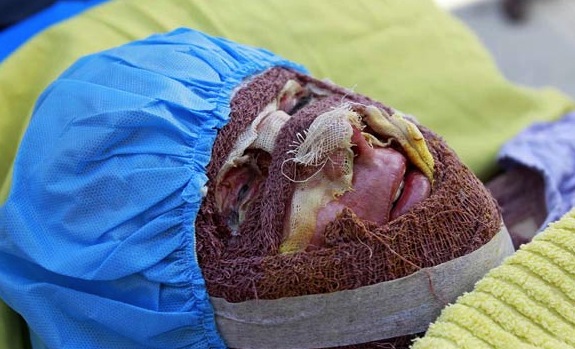
by Warren L. Nelson
The acid attacks on a number of young women in Esfahan have clearly rattled many hardliners and put them on the defensive.
No one in any position of authority has defended the attacks. In fact, hardliners are bending over backward to condemn them. But they have been put on the defensive because in recent months the hardliners have called for firmer enforcement of the dress code—and that is widely seen as having encouraged the acid attacks.
As per usual, basic facts are in dispute. Esfahan province Governor General Rasul Zargarpur said there have been four attacks between September 6 and October 15, with none since then. But opposition reports speak of as many as 15 attacks.
The first news of any of the acid attacks was reported by the Iranian Students News Agency (ISNA) October 16. The police, as per usual, had not warned the public about the attacks but preferred to cover up the news.
Some reports assert that one woman has died, though the government has not confirmed that.
In what appears to have been an effort to calm public outrage, a senior police officer announced last week that “three or four” suspects had been arrested, a lack of precision that raised eyebrows. A few days later, the police said those arrested had been released for lack of evidence—not a reason normally cited for releasing suspects, who are often held months while the police seek evidence against them.
On Monday, Zargarpur in Esfahan said 10 suspects had now been arrested while the Interior Ministry in Tehran said four has been arrested and the man appointed to head the investigation said no one had been arrested.
The deputy chief of the national police, Hossain Zolfaqari, insisted that only a single individual, who had not been arrested, was involved. That was an apparent effort to portray the crimes as a lone wolf event and not some mass effort inspired by hardline rhetoric against women violating the dress code.
However, the daily Sharq gave some support to Zolfaqari. Sharq said an analysis of the acid used in the attacks showed it all had the same composition and therefore came from the same stock.
The single perpetrator argument failed on another basis, however. Most of the attacks have reportedly been launched from motorcycles. Such attacks routinely involve two people—one to drive and one to shoot, flay or, in these cases, throw acid at the target.
Many hardliners have taken to asserting that the attacks have nothing to do with the issue of the dress code. They do not say how they reach that conclusion. Nor do they provide any other motive beyond saying the attacks are probably the result of some personal dispute.
President Rohani joined in assailing the vigilante attacks last week in a speech in Zanjan that was televised nationally. Rohani had been put on the defensive previously by hardliners, and he seemed to see the acid attacks as an opportunity to knock the hardliners off balance.
He did not specifically mention the acid attacks. Instead, he took out after conservatives in the Majlis who are pushing legislation to authorize private citizens to enforce the dress code—legislation that many see as having inspired the acid attacks.
“The sacred call to virtue is not the prerogative of a select group of people, a handful taking the moral high ground and acting as custodians. It is upon all Muslims to exhort love, respect for others and human dignity,” Rohani told a cheering crowd.
“Rue the day some lead our society down the path to insecurity, sow discord and cause rifts, all under the banner of Islam,” he said, his voice shaking with emotion.
“Rue the day we see vice manifested only in bad hejab and we overlook lies, slander, corruption and bribery as bigger vices,” Rohani told the crowd where women were standing in a separate section from men.
“I want to see our Majlis’s actions resulting in more unity, more cohesion, and more jobs for our young people. No vice is above joblessness, poverty and lack of opportunity to a good education,” he said.
The government appears to be trying hard to tamp down media coverage that has aroused the public about the acid attacks, much as the media frenzy in the United States has sparked mass fear of Ebola.
The Kaleme opposition website reports that photojournalist Arya Jafari, who heads the photo department of the Iranian Students News Agency (ISNA) in Esfahan and has published several photos of protests, was arrested at his home and his personal belongings searched and confiscated.
Without any explanation, the Mehr news agency removed a page of photos of the demonstrations against acid attacks in Esfahan.
The Fars news agency, which is linked to the Pasdaran, referred to the reports by some media outlets as being “in line with foreign media.”
Female Deputy Shahla Mir-Galobayat called the acid throwing in Esfahan “the West’s new scenario” and pointed out that the attacks came suspiciously just as a bill about dress code enforcement is moving through the Majlis.
A Tehran city councilor called on the Judiciary to investigate media reports that connect acid throwing to “moral-enforcement bodies” and equated those reports with “the sedition of 2009.”
Iran’s prosecutor general said any attempt to link acid throwing with dress code enforcement is “the work of anti-revolutionaries.”
Some are apparently feeding on the growing fear of acid attacks. The Tehran police said they had detained a man on the west side of the capital after a number of residents contacted police to say an unknown caller had threatened them with acid attacks.
Tehran Police Chief Hossain Sajedi-nia said the main was arrested when he was discovered making a threatening call from a phone booth.
Sajedi-nia didn’t help his credibility, however, when he said the man had confessed he made the calls “under the influence of foreign satellite channels.”
The attacks prompted from 1,000 to 2,000 Esfahanis to demonstrate last Wednesday outside the Esfahan office of the Judiciary, an unusually large number to join an unauthorized protest. Small numbers protested in Tehran. The International Campaign for Human Rights in Iran said the police used truncheons and tear gas to disperse the crowd in Esfahan.
Judiciary Chairman Sadeq Larijani named Prosecutor General Gholam-Hossain Mohseni-Ejai to head the investigation into the attacks. Mohseni-Ejai, a man not known for a gentle manner, minced no words in condemning the attacks, calling them “inhuman, unlawful, violent and anti-Islamic.”
Justice Minister Mostafa Pur-Mohammadi went further, calling the attacks “sabotage and terrorism,” thus making the attacks a political crime.
Many news reports have asserted that Esfajan’s Friday prayers leader, Mohammad Taqi-Rahbar, publicly said that “promoting virtue and preventing vice” must go beyond a verbal notice. Four days after news about the acid attacks was made public, however, he denied that. “I didn’t say the warnings should go beyond verbal notice.” But he continues to be the target of many critics who see him as the personal inspiration for the attacks.
In Tehran, one of the hardliners who leads Friday prayers there, Ayatollah Ahmad Khatami, called for the attackers to be punished both for injuring the victims and causing “damage to the dignity of the Islamic system.” In addition, he called for media outlets that blamed hardliners for the attacks to be punished. He said, “These websites and newspapers that have accused the Islamic system and the religious forces must be pursued. The owners and managers must be punished and held accountable for their lies.”
Although the government has denied any connection between the acid attacks and the dress code, the daily Farhikhte-gan wrote October 20 that “families of the Esfahan victims have claimed that, before throwing the acid on the victims, the perpetrators said, ‘We confront women who display bad hejab.’”
Abbas-Ali Mansuri-Arani, a member of the Majlis National Security Committee, said the acid attacks are probably the work of “foreign intelligence services.” He said, “Some are trying to connect this issue to the discussion about hejab, chastity and advancing the religious duty of promoting virtue and preventing vice. This is exactly what ISIS is doing in Iraq and Syria, acting against Sharia in order to provide a violent portrayal of Islam.”
The daily Etemad described what might have been an exaggerated picture of life in Esfahan. “The city’s women and girls are now providing security for themselves by appearing less on public roads and locking themselves up at home…. Those who do come out, roll down their car windows with fear and trepidation, finish what they have to do on the streets quickly, so that they can confine themselves inside their cars with the windows rolled up again.”
The Majlis still has before it a bill to authorize private groups to enforce the dress code, a bill the police and the Rohani Administration oppose and which many see as inspiring the acid attacks.
Last Tuesday, the Majlis voted to add a new article to the bill. That provision states, “No individual or group has the right to attempt criminal acts such as insults, libel, beating, injuring or murder of others under the umbrella of ‘promoting virtue and preventing vice’,” which is a Qoranic injunction.






















